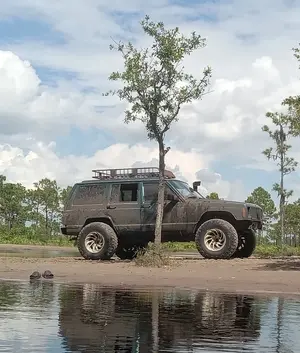So the starter died on my 28 year old jeep. The starter was actually pulled from a 32 year old jeep when I first got this one. While driving 2 weeks ago, I noticed the burning smell, and when I got where I was going, I shut down the engine to wait for a friend. When I tried to start it, it was totally dead.
I ordered a new (not rebuilt) starter and installed it 2 weeks ago. After driving about a mile with the new starter, the same burning smell appeared, and on pulling over and shutting down, the body of the starter motor was hotter than the engine itself. And it would not restart.
So after two burned out starters in a week on this 28 year old vehicle, I got another new starter, then bypassed the starting circuitry completely by installing a relay and on the dashboard, a pushbutton. I ran a wire from the relay to the pushbutton, and wiring directly from the battery, through the relay, to the starter solenoid.
It works perfectly now, and I don't have to worry about the "spooky" original wiring keeping the starter engaged and burning it out again. I just have an extra starting step. I turn the key to the run position, then hit the pushbutton until the engine starts, and release it.
One of my neighbors who had come by and seen part of the process told me that the "normal" thing to do in this situation is to take the vehicle to an automotive electrician for troubleshooting and repair, and that it was "weird" to do what I did.

The jeep is 28 years old. It isn't a showpiece. It's a workhorse. Not starting with a simple key turn isn't necessarily a bad thing. (Think anti-theft feature.)
I spent less than $10 on this repair, and less than an hour of my time installing the relay and pushbutton. I didn't have to drop the jeep off anywhere and wait days for troubleshooting and repair, and I didn't have to spend hundreds (or even thousands?) of dollars.
Why would someone not do this if they understand basic wiring?
I ordered a new (not rebuilt) starter and installed it 2 weeks ago. After driving about a mile with the new starter, the same burning smell appeared, and on pulling over and shutting down, the body of the starter motor was hotter than the engine itself. And it would not restart.
So after two burned out starters in a week on this 28 year old vehicle, I got another new starter, then bypassed the starting circuitry completely by installing a relay and on the dashboard, a pushbutton. I ran a wire from the relay to the pushbutton, and wiring directly from the battery, through the relay, to the starter solenoid.
It works perfectly now, and I don't have to worry about the "spooky" original wiring keeping the starter engaged and burning it out again. I just have an extra starting step. I turn the key to the run position, then hit the pushbutton until the engine starts, and release it.
One of my neighbors who had come by and seen part of the process told me that the "normal" thing to do in this situation is to take the vehicle to an automotive electrician for troubleshooting and repair, and that it was "weird" to do what I did.

The jeep is 28 years old. It isn't a showpiece. It's a workhorse. Not starting with a simple key turn isn't necessarily a bad thing. (Think anti-theft feature.)
I spent less than $10 on this repair, and less than an hour of my time installing the relay and pushbutton. I didn't have to drop the jeep off anywhere and wait days for troubleshooting and repair, and I didn't have to spend hundreds (or even thousands?) of dollars.
Why would someone not do this if they understand basic wiring?